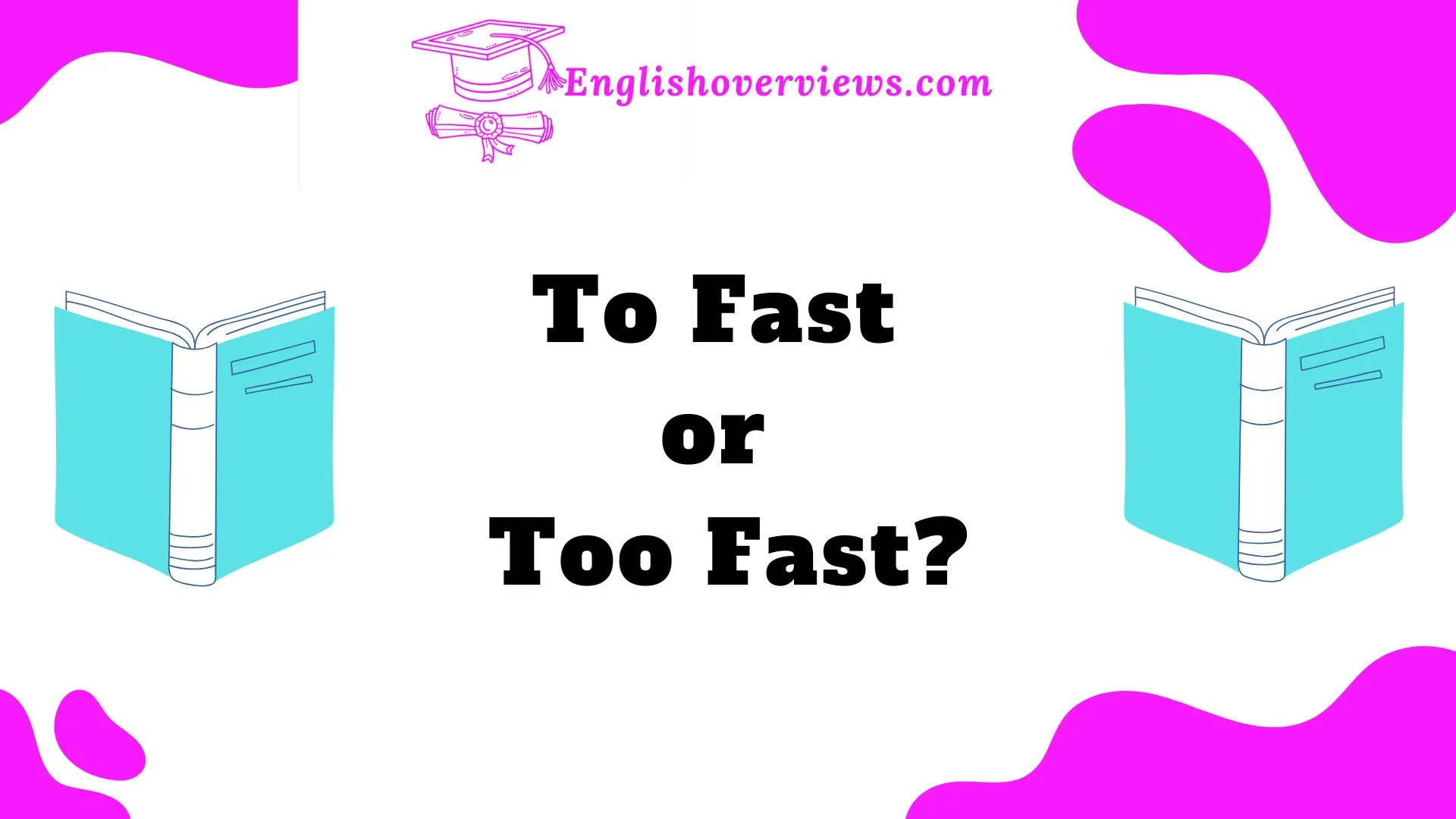English grammar can be tricky, even for native speakers. One common area of confusion is the use of “to” and “too.” These tiny words might seem simple, but they play very different roles in sentences.
Whether you’re writing an email, composing a social media post, or crafting a formal document, knowing when to use “to” or “too” is essential for clear communication.
In this guide, we’ll dive deep into the grammar, tackle common mistakes, and provide real-world examples to help you master these words. Let’s clear up the confusion once and for all
Understanding the Grammar: ‘To’ vs ‘Too’
Let’s start with the basics. What’s the difference between “to” and “too”?
‘To’ Explained
- Part of Speech: Preposition or infinitive marker.
- Uses:
- Preposition: Indicates direction, place, or position.
- Example: I’m going to the store.
- Infinitive Marker: Paired with verbs to create infinitives.
- Example: She loves to dance.
- Preposition: Indicates direction, place, or position.
Table: Common Uses of “To”
| Usage | Example Sentence |
| Direction | I’m traveling to New York. |
| Purpose | He came to help. |
| Comparison | She prefers coffee to tea. |
| Infinitive Verb | I need to finish this project. |
‘Too’ Explained
- Part of Speech: Adverb.
- Uses:
- Excessive Amount: Indicates something beyond what is necessary or desired.
- Example: This coffee is too hot.
- Addition/Agreement: Means “also” or “as well.”
- Example: I’d like some cake, too.
- Excessive Amount: Indicates something beyond what is necessary or desired.
Table: Common Uses of “Too”
| Usage | Example Sentence |
| Excessive Amount | It’s too expensive. |
| Adding/Agreeing | I’ll join the team, too. |
Key Takeaway: “To” points toward something, while “too” emphasizes excess or agreement.
Common Misuses of ‘To’ and ‘Too’
Even fluent English speakers mix these up sometimes. Let’s look at some common errors:
Error 1: Swapping ‘To’ and ‘Too’
- Incorrect: I’m going too the park.
- Correct: I’m going to the park.
Error 2: Forgetting the Extra ‘O’ in ‘Too’
- Incorrect: This is to much for me.
- Correct: This is too much for me.
Why Does This Happen?
- Homophones: Since “to” and “too” are pronounced the same, they’re easy to confuse.
- Autocorrect Issues: Spellcheck tools might not catch the difference if the incorrect word still makes sense.
Quick Tip: If you mean “also” or “excessively,” remember that “too” has one extra “o” because it gives extra meaning!
When ‘Too’ Goes Before Adjectives
One of the most common uses of “too” is to modify adjectives. It emphasizes that something is excessive or beyond normal.
Examples of ‘Too’ with Adjectives
- The room is too small for a party.
- It’s too late to cancel the order.
- She’s too tired to continue hiking.
Case Study: Planning a Trip
Imagine you’re booking a vacation:
- You pick a flight but realize it’s too expensive for your budget.
- The hotel you like is too far from the beach.
- You finally find a place that isn’t too noisy—perfect!
Examples of ‘Too’ in Excessive Situations
“Too” often signals that something has gone overboard. Here are more examples to clarify:
- The soup is too salty to eat.
- This sweater is too big for me.
- He drove too fast and got a ticket.
Real-World Example:
In 2021, a viral social media post misused “too” and became a meme. Someone wrote: “It’s to hot to handle!” Grammar enthusiasts quickly corrected it to “It’s too hot to handle!” The takeaway? Small mistakes can change how professional you appear online.
The Adverb ‘Too’: Enhancing Your Vocabulary
Using “too” effectively can make your language richer. It’s a versatile word that adds emotion and emphasis.
Examples
- That’s too good to be true.
- I’m too excited to wait!
Tip: Overusing “too” can make your writing sound repetitive. Instead, try synonyms like “excessively” or “overly” to add variety.
Expressing Emphasis with ‘Too’
“Too” can also emphasize agreement or addition:
- I think so, too.
- She’s coming, too.
Pro Tip: When adding emphasis, try pairing “too” with other adverbs for a stronger impact:
- It’s not just good—it’s too incredibly good to miss!
Showing Addition and Agreement
When “too” means “also,” it can make your sentences more conversational:
- Can I come, too?
- I’d like some dessert, too.
Visual Breakdown:
| Meaning | Sentence Example |
| Also | He likes pizza, too. |
| In Addition | I’ll have a coffee, too. |
Synonyms for ‘Too’
“Too” has many alternatives. Use these to diversify your writing:
| Synonym | When to Use |
| Excessively | For formal or dramatic contexts (excessively tired). |
| Overly | For mild emphasis (overly cautious). |
| Additionally | For professional settings (additionally noted). |
Grammar Tips: Remembering the Difference
Struggling to remember when to use “to” vs “too”? Here are some tips and tricks:
- Double ‘O’ Rule:
If it means “also” or “excessively,” remember that “too” has an extra “O.” - Preposition Check:
If the word describes direction or purpose, it’s probably “to.” - Practice Sentences: Write 10 sentences using each word correctly. Repetition helps solidify grammar rules.
Visual Tricks to Differentiate ‘To’ and ‘Too’
Infographic Idea: Imagine the word “too” as a seesaw. It adds more weight (“extra” or “excess”) to a sentence. Meanwhile, “to” acts like a straight arrow pointing to a destination or goal.
Mnemonics for Correct Usage
Here’s a simple mnemonic:
- “Too” means ‘extra’—and it has an extra ‘O.’
‘Too Fast’ or ‘Too Quick’? Exploring Adverbs of Manner
Both “fast” and “quick” can pair with “too,” but their usage differs:
| Adverb | Usage | Example |
| Too Fast | Refers to speed or pace. | He ran too fast. |
| Too Quick | Refers to short duration. | She left too quick. |
When ‘To’ and ‘Too’ Sound Alike: Homophones Clarified
Since “to” and “too” sound identical, context is key. Consider this:
- I need to talk to you. (Purpose)
- I need a break, too. (Addition)
Final Thoughts: Mastering ‘To’ and ‘Too’ in Everyday Communication
With practice, “to” and “too” will no longer trip you up. Remember, these small words carry big meaning. Use the tips, tables, and examples in this guide to ensure your writing stays clear and professional.
FAQs
Q1: What’s the easiest way to remember the difference between ‘to’ and ‘too’?
A: Think of “too” as having an extra “O” for “extra meaning” (excess or addition).
Q2: Can ‘to’ ever mean ‘too’?
A: No, they have distinct meanings. Context will always clarify which to use.
Q3: Is ‘too fast’ always negative?
A: Not necessarily. It depends on the context, e.g., He’s progressing too fast for me to keep up.
Q4: Are there other homophones like ‘to’ and ‘too’?
A: Yes, “two” is another homophone. Example: I have two tickets to the concert.
Q5: How can I practice using these words correctly?
A: Write sentences with both “to” and “too,” and check them with a trusted grammar resource.

English Overviews is a resourceful website dedicated to providing valuable content related to grammar and vocabulary. Muhammad Haroon has made notable contributions, sharing insights on various subjects, including WordPress themes and plugins. The primary goal of the site is to help users improve their English language skills effectively.











